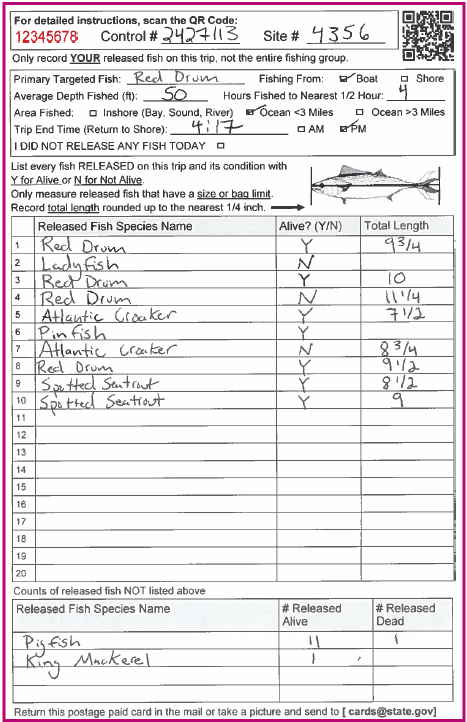ACCSP Pilot Study Uses Catch Cards to Get Angler Data on Released Fish
Fish that are released back into the water represent an increasingly large proportion of total catch for many fish populations. Therefore, testing new methods to collect more detailed information on released catch is critical to fish stock assessments.
“The magnitude of recreational discards has grown over the last decade(s) and may even comprise the largest source of mortality in some stocks,” said Dr. Matthew Nuttal, fish biologist at NOAA Fisheries’ Southeast Fisheries Science Center.
Collecting accurate and complete information about released fish from recreational anglers has always been challenging. While the headboat sector actively monitors and documents observed releases, other types of recreational fishing, like fishing from shore, private/rental boat, and charter boats provide limited or no length data for released catch.
“Released fish are not observable at the dock through in-person catch surveys, so these data often remain unverified,” said Nuttall. “This can complicate the use of recreational catch data in stock assessments.”
In addition, it is uncertain whether or not the fish was released dead or alive.
Stock assessment scientists have a critical need for these data, which help them evaluate released fish mortality, size of fish for size- or age-based assessments, and total removals from a specific fishery. This, in turn, helps determine species’ abundance and health.
Testing a New Approach to Collect Released Fish Data

In response to this growing need for data on released catch, the Atlantic Coastal Cooperative Statistics Program’s (ACCSP) Recreational Technical Committee developed a pilot project that uses catch cards to collect supplemental released fish information from a representative sample of anglers.
This project offers a novel and cooperative approach in close coordination with Atlantic state partners and NOAA Fisheries to supplement existing released catch information obtained through NOAA Fisheries’ Access Point Angler Intercept Survey (APAIS) and to collect additional fishing depth and length measurements of released fish. The intent of the project is to test a method for collecting quality released catch information to improve released catch estimates.
The pilot project launched in May and runs through December 2025. Participating states include Massachusetts, Rhode Island, Connecticut, New York, Maryland, North Carolina, South Carolina, and Georgia. The primary focus is to capture released fish data from private and rental boats; however, participating state partners may also collect these data from anglers shore fishing.
Pilot Project Benefits
Getting released catch information directly from anglers helps assure the data best represent the recreational fishing community’s activities.
“Collecting more accurate released catch and mortality information through catch cards will provide valuable data currently unavailable to stock assessment scientists,” said Alex DiJohnson, program manager at ACCSP. “Access to these data will help fisheries managers make more informed decisions to sustainably manage our nation’s marine fish stocks.”
In addition, the pilot offers an opportunity to educate anglers about the importance of accurate information on released catch in fisheries science and management. It also provides a platform for sharing information on discard mortality, barotrauma, and safe fish-handling techniques.
How it Works
Before selected anglers start fishing, field interviewers working for state agencies will provide them waterproof catch cards, a measuring tape, a pencil, and a brief overview of the project.
Catch cards include fields for the following basic information:
- Date
- Fishing mode (private/rental boat, shore)
- Species targeted
- Hours fished
- Area fished (ocean <=3 miles, ocean >3 miles, or inland)
- Depth fished
- Trip end time
Catch information questions include:
- Number of fish released per species
- Disposition (thrown back dead or alive)
- Released fish lengths
Once anglers complete their trips and record their released catch data, they can drop their pre-paid postage catch card in the mail; return the catch card directly to the state survey interviewer if still on site; or email a picture of the card via the state-specific email at the bottom of every card.
Anglers who return from their trip and give their catch card to a field interviewer will be asked to complete an APAIS interview. The catch card does not replace APAIS.
Evaluating Results
ACCSP and state partners will analyze the results of the pilot, focusing on:
- the numbers of private/rental boat catch cards returned,
- the data quality provided to stock assessors, and
- a comparison of released catch information provided through APAIS and the catch card pilot.
ACCSP will use these results to help determine whether or not to extend the project into 2026 for continued analyses and potential future implementation.
Cover Photo credit: Returnemright.org
